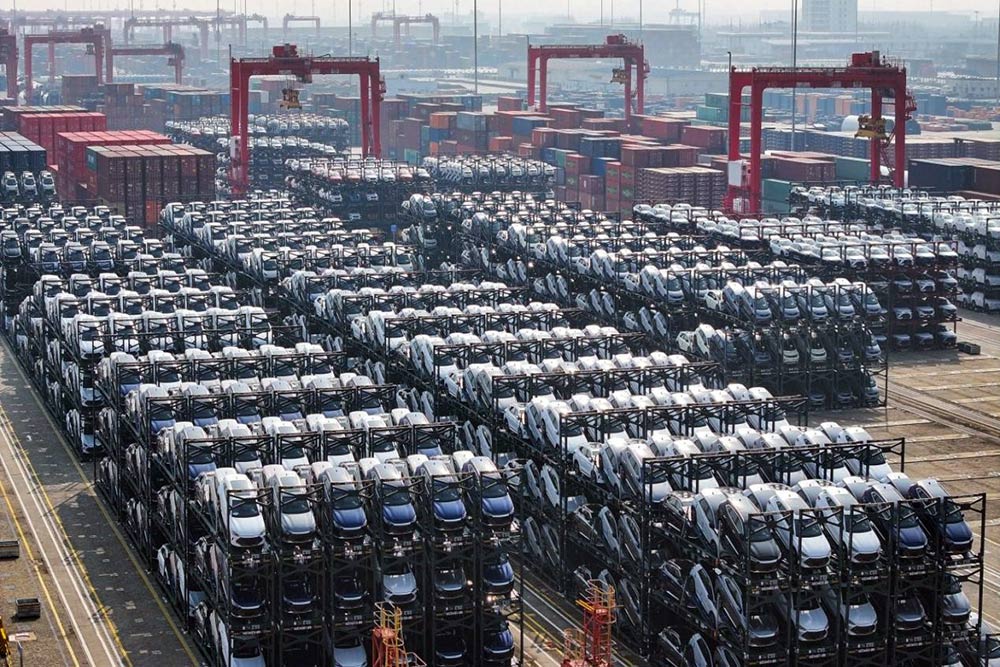
大多数人在提起电动汽车时,首先浮现脑海的公司一定是特斯拉(Tesla Inc.),但几乎令人难以想象的是,这家公司或许已在中国这个全球最大、最先进的电动汽车市场度过了它的黄金时期。
中国乘用车市场信息联席会(Passenger Car Association)的数据显示,埃隆·马斯克执掌的特斯拉在中国市场的销量已连续五个月同比下滑。今年2月特斯拉出货量同比暴跌49%,只有30,688辆,创下自2022年7月以来的最低月度出货量。当时正值新冠疫情中期,月度出货量仅28,217辆。
为提高生产效率和重新推出热销的Model Y车型,位于上海郊区的特斯拉工厂对部分生产线进行了改造,因此产量下降并需要时间恢复本就在预料之中。但即使在此之前,特斯拉的销量就已呈现颓势。
中国前12大车企的市场份额涵盖纯电、混动及燃油车型,排名第11位的特斯拉市场份额已跌破5%。事实上,多数车企(尤其是国际品牌)的市占率曲线均呈下滑态势。
反观比亚迪(BYD Co.),自2022年3月起全面停止生产纯燃油车,其市占率正逼近15%。上月该公司纯电与混动乘用车销量突破31.8万辆,同比激增161%。这家总部位于深圳的车企海外销量亦以67,025辆再创新高。
比亚迪的成功正是特斯拉败退的主要原因之一。
马斯克在政治上的言行令许多人反感,随着他越来越多地涉足政治,特斯拉在全球多地销量暴跌。例如在德国市场,上个月尽管当地电动汽车整体注册量激增,但特斯拉的销量却骤降76%,仅有1,429辆。而特斯拉在中国市场的败退,更多源于产品线单一且过时,面对比亚迪等本土品牌推出的新颖车型显得力不从心。
中国汽车技术研究中心(China Automotive Technology and Research Center)的数据显示,特斯拉去年年底的在华销量占比跌至2.6%,创12个月新低。
价格也揭示了比亚迪如何攻占特斯拉的核心阵地。
特斯拉上海工厂生产的Model Y和Model 3没有大幅降价,仅小幅下调了价格,平均售价仍维持在约3.35万美元。
而比亚迪今年最畅销的运动型两厢轿车宋Plus(Song Plus),根据不同配置降价8%-18%,顶配版零售价约2.1万美元,远低于特斯拉竞品。
比亚迪另一热销车型海鸥(Seagull)均价更降至9,900美元,今年已售82,435辆。
中国车企在适合本地驾驶环境的智能驾驶系统开发方面亦取得显著进展。
比亚迪年初宣布将高阶智驾系统“天神之眼”(God’s Eye)下放至部分售价最低的车型,使车道保持、自适应巡航等功能不再专属中高端车主。
中国市占率第四的吉利汽车(Geely Automobile Holdings Ltd.)近日透露,其AI智驾系统将覆盖银河(Galaxy)、极氪(Zeekr)、领克(Lynk)等全系品牌,G-Pilot技术可提供高速公路自动驾驶和自动泊车等功能。
特斯拉并非停滞不前。除备受期待的Model Y改款车型(这款运动型多功能汽车前脸新增贯穿式LED灯带,致敬Cybertruck的设计风格)外,特斯拉上个月在中国推出了辅助驾驶功能,其水平接近在美国推出的全自动驾驶(FSD)。该功能的开通费用为6.4万元(约合8,800美元)。这笔费用几乎等同于购买一辆比亚迪整车的价格。
对特斯拉而言,调整定价策略(涵盖辅助驾驶功能与整车售价)已迫在眉睫。
借鉴美国市场的FSD分级套餐或订阅模式,或能提升产品的吸引力。中国消费者非常重视车载智能系统。这正是特斯拉在马斯克个人魅力褪色时可把握的机遇。
特斯拉还可以增加本地零部件采购,并借力中国完善的产业生态,或许能打造出真正以科技驱动的电动汽车产品,而不仅是电力驱动的交通工具。
比亚迪深谙本土市场走势。其未来的挑战在于能否在即便面临关税壁垒的情况下,在海外主流市场复制国内的成功。建立国际品牌形象需要时间沉淀与持续投入。(财富中文网)
译者:刘进龙
审校:汪皓
大多数人在提起电动汽车时,首先浮现脑海的公司一定是特斯拉(Tesla Inc.),但几乎令人难以想象的是,这家公司或许已在中国这个全球最大、最先进的电动汽车市场度过了它的黄金时期。
中国乘用车市场信息联席会(Passenger Car Association)的数据显示,埃隆·马斯克执掌的特斯拉在中国市场的销量已连续五个月同比下滑。今年2月特斯拉出货量同比暴跌49%,只有30,688辆,创下自2022年7月以来的最低月度出货量。当时正值新冠疫情中期,月度出货量仅28,217辆。
为提高生产效率和重新推出热销的Model Y车型,位于上海郊区的特斯拉工厂对部分生产线进行了改造,因此产量下降并需要时间恢复本就在预料之中。但即使在此之前,特斯拉的销量就已呈现颓势。
中国前12大车企的市场份额涵盖纯电、混动及燃油车型,排名第11位的特斯拉市场份额已跌破5%。事实上,多数车企(尤其是国际品牌)的市占率曲线均呈下滑态势。
反观比亚迪(BYD Co.),自2022年3月起全面停止生产纯燃油车,其市占率正逼近15%。上月该公司纯电与混动乘用车销量突破31.8万辆,同比激增161%。这家总部位于深圳的车企海外销量亦以67,025辆再创新高。
比亚迪的成功正是特斯拉败退的主要原因之一。
马斯克在政治上的言行令许多人反感,随着他越来越多地涉足政治,特斯拉在全球多地销量暴跌。例如在德国市场,上个月尽管当地电动汽车整体注册量激增,但特斯拉的销量却骤降76%,仅有1,429辆。而特斯拉在中国市场的败退,更多源于产品线单一且过时,面对比亚迪等本土品牌推出的新颖车型显得力不从心。
中国汽车技术研究中心(China Automotive Technology and Research Center)的数据显示,特斯拉去年年底的在华销量占比跌至2.6%,创12个月新低。
价格也揭示了比亚迪如何攻占特斯拉的核心阵地。
特斯拉上海工厂生产的Model Y和Model 3没有大幅降价,仅小幅下调了价格,平均售价仍维持在约3.35万美元。
而比亚迪今年最畅销的运动型两厢轿车宋Plus(Song Plus),根据不同配置降价8%-18%,顶配版零售价约2.1万美元,远低于特斯拉竞品。
比亚迪另一热销车型海鸥(Seagull)均价更降至9,900美元,今年已售82,435辆。
中国车企在适合本地驾驶环境的智能驾驶系统开发方面亦取得显著进展。
比亚迪年初宣布将高阶智驾系统“天神之眼”(God’s Eye)下放至部分售价最低的车型,使车道保持、自适应巡航等功能不再专属中高端车主。
中国市占率第四的吉利汽车(Geely Automobile Holdings Ltd.)近日透露,其AI智驾系统将覆盖银河(Galaxy)、极氪(Zeekr)、领克(Lynk)等全系品牌,G-Pilot技术可提供高速公路自动驾驶和自动泊车等功能。
特斯拉并非停滞不前。除备受期待的Model Y改款车型(这款运动型多功能汽车前脸新增贯穿式LED灯带,致敬Cybertruck的设计风格)外,特斯拉上个月在中国推出了辅助驾驶功能,其水平接近在美国推出的全自动驾驶(FSD)。该功能的开通费用为6.4万元(约合8,800美元)。这笔费用几乎等同于购买一辆比亚迪整车的价格。
对特斯拉而言,调整定价策略(涵盖辅助驾驶功能与整车售价)已迫在眉睫。
借鉴美国市场的FSD分级套餐或订阅模式,或能提升产品的吸引力。中国消费者非常重视车载智能系统。这正是特斯拉在马斯克个人魅力褪色时可把握的机遇。
特斯拉还可以增加本地零部件采购,并借力中国完善的产业生态,或许能打造出真正以科技驱动的电动汽车产品,而不仅是电力驱动的交通工具。
比亚迪深谙本土市场走势。其未来的挑战在于能否在即便面临关税壁垒的情况下,在海外主流市场复制国内的成功。建立国际品牌形象需要时间沉淀与持续投入。(财富中文网)
译者:刘进龙
审校:汪皓
It’s almost unthinkable, but Tesla Inc., the company that comes to mind when most people think about electric vehicles, may have had its best days in China, the world’s biggest and most advanced EV market.
Elon Musk’s automaker has been backsliding in China for the past five consecutive months on a year-on-year basis, according to data from the country’s Passenger Car Association. Tesla’s shipments plunged 49% in February from a year earlier to just 30,688 vehicles, the lowest monthly figure since way back in July 2022, when it shipped just 28,217 EVs — and that was in the middle of Covid.
Tesla’s factory on the outskirts of Shanghai has had some of its production lines retooled for efficiency and to relaunch the popular Model Y, so it’s to be expected both that output dropped and will take some time to ramp back up. But even before that, the trend was heading in the wrong direction.
It shows the market shares of the top 12 automakers in China by sales for any type of car — electric, hybrid or otherwise. Tesla, at No. 11, is well under 5%. Indeed, most carmakers’ trend lines are sloping down, not up, especially the international ones.
But look at BYD Co. The company, which stopped making cars powered entirely by internal combustion engines in March 2022, has a market share heading toward 15%. It sold more than 318,000 fully electric and hybrid passenger vehicles last month, up 161% year-on-year. The Shenzhen-based carmaker also notched another record month for overseas sales, which hit 67,025 units.
Its success is a major reason why Tesla is losing.
While Tesla sales in other parts of the world are cratering as Musk wades deeper into politics many find unsavory — sales in Germany plunged 76% to only 1,429 cars last month, even as overall EV registrations jumped — in China, disappointing shipments have more to do with a narrow and dated lineup, particularly in the face of up-to-date and more exciting offerings from BYD and others.
Year-end data place Tesla’s share of domestic sales at 2.6%, the lowest in 12 months, according to figures compiled by the China Automotive Technology and Research Center.
Another chart shows how BYD has muscled into Tesla’s sweet spot.
Both the Model Y and Model 3, the two vehicles Tesla makes in Shanghai, have only had their prices trimmed, rather than slashed, and buying one still costs around $33,500 on average.
BYD’s best-selling model this year in China, a sporty hatchback called the Song Plus, has had its sticker price reduced by between 8% to 18%, depending on the car’s specs. The most expensive Song Plus EV retails for around $21,000 — much cheaper than a Tesla.
Another of BYD’s popular models, the Seagull, which has found around 82,435 buyers this year, comes in at an even more affordable $9,900, on average.
Chinese carmakers have also significantly upped their game when it comes to localized software tailored to domestic driving conditions.
BYD said earlier this year that it’s taking advanced driver-assistance to the masses by including its God’s Eye technology in even some of its cheapest cars. Now, features like lane keeping and adaptive cruise control will be for everyone, not only people who can afford mid- to high-end models.
Geely Automobile Holdings Ltd., China’s fourth-ranked carmaker by market share, said last week that its AI-powered pilot system will be added to all of its brands, including Galaxy, Zeekr and Lynk. The G-Pilot technology will enable cars to navigate highways and self park.
Tesla isn’t standing still. Apart from its highly anticipated Model Y refresh — the sport utility vehicle now features a thin LED light running across its front end, reminiscent of the Cybertruck — Tesla last month enabled driver-assistance capabilities in China similar to those marketed as Full Self-Driving, or FSD, in the US. The software will be switched on for customers who’ve paid 64,000 yuan ($8,800). Then again, that’s almost as much as what it would cost to buy an entire one of BYD’s cars.
For Tesla, a recalibration of its pricing strategies, both for its driver-assistance functions and the vehicles themselves, is paramount.
Offering tiered FSD packages, or a subscription option like what Tesla has in the US, could broaden the appeal of its EVs. Chinese consumers place a lot of importance on intelligent software features in cars. That’s something Tesla could capitalize on as Musk’s pulling power wanes among some consumers.
Tesla could also look to integrate more locally sourced components and leverage China’s robust supply chain so that it’s not only building cars powered by electricity, but also by technology.
BYD understands those domestic market dynamics well. The key for the company will be whether it can replicate its success in big car markets outside of China, even in the face of tariffs. It will take time and substantial investment to establish its brand abroad.






